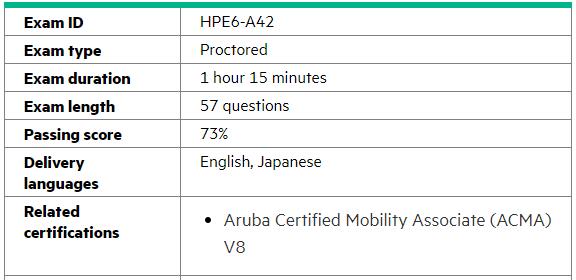HPE6-A42 Practice Test Questions - Implementing Aruba WLAN (IAW) 8
If you are want to pass your HPE6-A42 exam, Passquestion is the right platform where you can get HPE6-A42 exam new questions with accurate answers. Passquestion offer you latest and relevant HPE6-A42 Practice Test Questions that assist you to get ready and pass HPE6-A42 in an initial try.You will clear HPE6-A42 Implementing Aruba WLAN (IAW) 8 exam in just first attempt by getting HPE6-A42 Practice Test Questions from Passquestion.
HPE6-A42 Exam description - Implementing Aruba WLAN (IAW) 8
HPE6-A42 Implementing Aruba WLAN (IAW) 8 exam tests your knowledge and skills to deploy AOS 8 single-site, on premise, geographically simple enterprise WLANs.

HPE6-A42 Exam Objectives Covered In Real Test
30% Describe and differentiate WLAN fundamentals and Aruba Architectures
29% Identify and differentiate the functions, features, and capabilities of Aruba single-site on-premise enterprise solutions.
27% Configure, validate, and troubleshoot Aruba WLAN secure employee and guest solutions.
14% Manage and monitor Aruba solutions.
Share HPE6-A42 Practice Questions and Answers Below:
1.What is a reason for a company to choose to deploy an Aruba 7024 Mobility Controller (MC) rather than an Aruba 7010 MC?
A. to support 802.11ac Aps rather than only 802.11n APs
B. to support more wireless users
C. to support more POE devices directly connected to the MC
D. to support a faster firewall throughput rate
Answer: C
2.A company wants to provide wireless access for guests with their Aruba solution.
Which configuration feature requires the customer to purchase PEFNG licenses?
A. redirection of guests to an external captive portal
B. provision of DHCP services to unauthenticated guests
C. addition of custom rules to control access for auhtnticated guests
D. customization of the internal captive portal login page
Answer: C
3.A company has an Aruba Mobility Master (MM)-based solution. A network administrator wants to collect and analyze information about clients and access points (APs) over extended periods of time.
What should the administrator do to achieve this goal?
A. Add Aruba AirWave to the solution.
B. Run a Traffic Analysis report on the MM.
C. Make sure that MM has sufficient AppRF licenses.
D. Enable archival from the MM interface Maintenance windows.
Answer: A
4.What is a requirement for the Dashboard > Traffic Analysis window on the Aruba Mobility Master (MM) to show data?
A. Airmatch and ClientMatch must be enabled.
B. The solution must have active PEFNG licenses.
C. Firewall policies must include application filtering rules.
D. WLANs must use the decrypt-tunnel forwarding option.
Answer: B
5.How can network administrators upgrade AirMatch on an Aruba Mobility Master (MM)?
A. Upgrade Client Match as part of a global software upgrade, and upgrade AirMatch separately as a loadable service module (LSM).
B. Upgrade AirMatch as part of a global software upgrade, and upgrade Client Match separately as a loadable service module (LSM).
C. Upgrade AirMatch and Client Match through a global software upgrade.
D. Upgrade Client Match and AirMacth separetely as loadable service modules (LSMs).
Answer: D
6.An AP operates on channel 6.
Which device causes the most significant and consistent interference with the signal?
A. cellular phone
B. weather radar
C. wireless security camera operating on channel 8
D. AP operating on channel 11
Answer: C
7.A network administrator needs to create an Aruba firewall rule that permits wireless users to receive DHCP settings when they first connect to the Aruba solution.
What are the correct source and destination aliases for the rule?
A. source = any and destination = user
B. source = any and destination = any
C. source = user and destination = user
D. source = user and destination = any
Answer: B
8.How can network administrator provide high availability for APs deployed in an Aruba Mobility Master (MM)-based architecture?
A. Establish clusters of Mobility Controllers (MCs).
B. Configure MM to provide backup AP tunnel termination in case of controller failure.
C. Deploy all licenses locally yo APs, so that they can continue to function if they lose contact with their controller.
D. Configure APs to convert to controller-less Instant AP mode during controller failure.
Answer: A
- TOP 50 Exam Questions
-
Exam
All copyrights reserved 2025 PassQuestion NETWORK CO.,LIMITED. All Rights Reserved.

